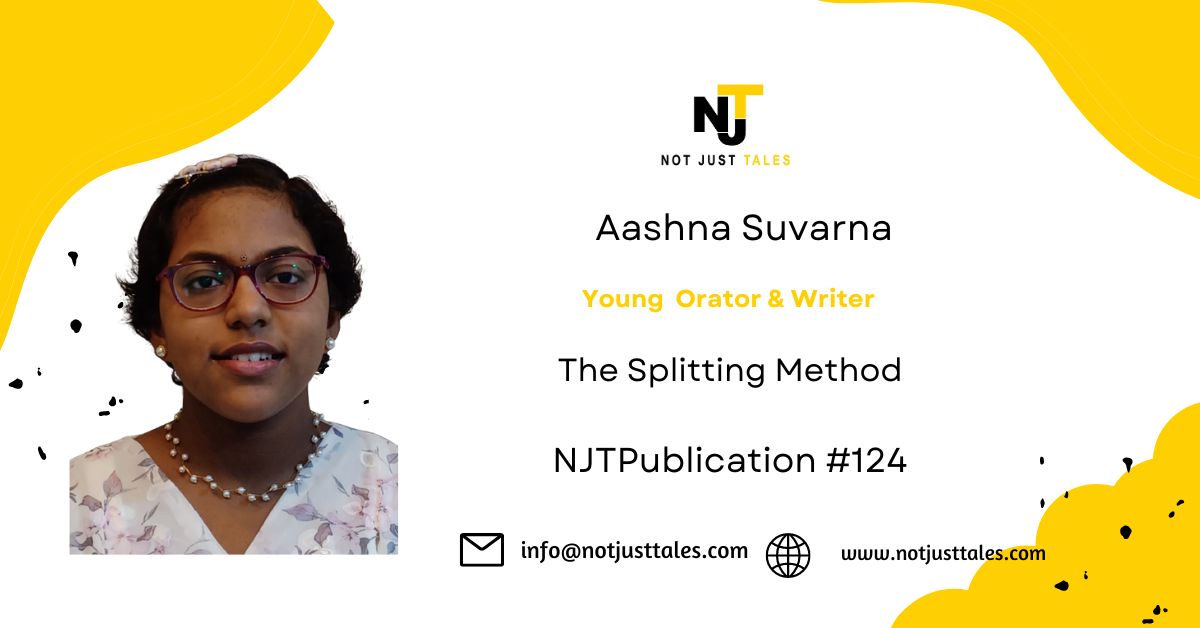The Splitting Method I Student Aashna Suvarna I Little Writers Program
By admin in Creative Writing, Descriptive Writing, Scientific Stories on May 4, 2023
 An original story on the germination process, written by our student Aashna Suvarna.
An original story on the germination process, written by our student Aashna Suvarna.
Aashna is 13 years old young writer from Mumbai. She loves music, reading and writing. We are proud to have her as a student of the Little Writers Program, an Online Creative Writing Program using Applied Storytelling & Theatre tools under the mentorship of Trainer Khusshbo Chokhaani. We congratulate Aashna for this exemplary true self-expression.
The Splitting Method
Chatters, platters, discussions, conversations, and occasional shouts and screams filled the class until a very enthusiastic and jocular voice filled the classroom saying, “Good Morning, Class.” Everyone became a dog with two tails the moment they heard, every head looked up to see the usual “grinning like a Cheshire cat” face of Miss Sanskriti and everyone stood up excitedly to wish their favorite teacher. This elation was not something unforeseen as Miss Sanskriti was adored by every student as her classes were more fun than a barrel of monkeys.
” You should stop giving me that goooooood mooorrrrrnnnnnnnniiinnnnnng ttttttteacccccccccccchhhhherrrrr. We will be learning about the electrolysis process today,” she said while writing today’s topic on the blackboard.
Miss Sanskriti took a deep breath and spieled off “Electrolysis is a technique in chemistry and manufacturing that uses the direct electric current (DC) to drive otherwise non-spontaneous chemical reactions. The voltage that is needed for electrolysis to occur is called the decomposition potential.” The children stared blankly at the teacher as if they had absent seizures.
“Fine, I was just kidding with you. Before we had to the concept, let’s get the word. “Electrolysis” is pronounced as uh·lek·traw·luh·suhs. The term ‘electrolysis’ is easy to remember if you break it down into its parts. The first part of the word, electro, refers to electricity. Scientists use the second part of the word, lysis, to describe the process of splitting or separating something. So the word “Electrolysis” means to break down, split, or separate a substance using electricity.
It had begun to rain heavily. Seeing this, she said, “Look into the sky on a stormy day as lightning bolts streak through the sky.” One of the lightning bolts struck one of the trees and broke it into two parts. Seeing the students’ thunderstruck faces, the teacher continued “Electricity can be scary, but it can also be helpful. Electricity is a rudimentary part of nature and one of the most widely operated forms of energy. Scientists have learned how to harness the power of electricity to split elements and compounds. This process is called electrolysis. Elements are substances made up of a single type of atom, while compounds are substances made up of elements. Electrolysis is the process of utilizing electricity to split water into hydrogen and oxygen. This reaction takes place in a unit called an electrolyzer.”
While drawing the diagram of the electrolyzer, she articulated “In its most basic form, an electrolyzer contains a cathode (negative electrode), an anode (positive electrode), and a membrane. The system also includes pumps, vents, storage tanks, a power supply, a separator, and other components. So basically, you place the electrolyzer in a bucket or beaker of water. Once the electrolyzer is placed inside the water, positive charges are attracted to the cathode, like a magic stick that attracts positive charges. And the anode is also similar to the cathode. The hydrogen is drawn to the anode rod, while oxygen is attracted to the cathode. And that is how electrolysis happens.
Suddenly, one of the students rose from his seat and asked, “Miss, electrolysis is cool to look at but is it useful to us”.”Of course, there are many uses of electrolysis. Some of them are the extraction and refining of metals, chemical production, and electroplating.”
The bell rang and Miss Sanskriti concluded the class. This is all about electrolysis, or rather a better word for it, “The Splitting Method”. Now quickly chant your prayers and run for your lunch break. I am not like your math teachers. I won’t take your freedom time away ” The class laughed and rushed out of the classroom.
Leave your valuable feedback in the comment box to motivate our student.

 An original story on the scientific concept of skeleton written by our student Harshvardhan Singh Shekhawat.
An original story on the scientific concept of skeleton written by our student Harshvardhan Singh Shekhawat.
Recent Comments